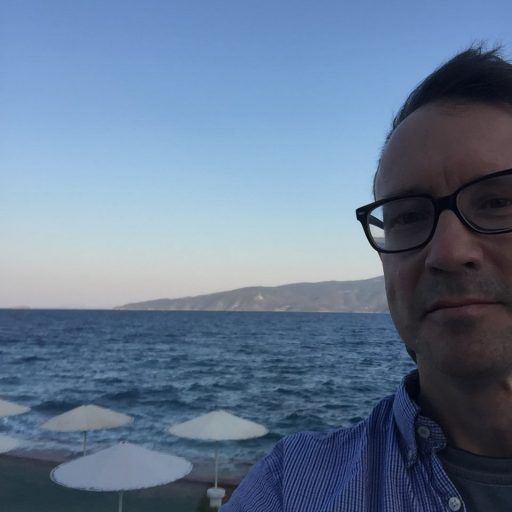
The Pompeii Artistic Landscape Project (PALP) is an online resource (under construction), based in a Linked Open Data (LOD) format, to encourage sitewide discovery, mapping, analysis, and sharing of information about Pompeian artworks in their architectural contexts. The goal of PALP is to dramatically increase the number of researchers and members of the public who can access, analyze, interpret, and share the artworks of the most richly documented urban environment of the Roman world: Pompeii.
The Pompeii Artistic Landscape Project (PALP) is a collaborative initiative between Eric Poehler at the University of Massachusetts Amherst and Sebastian Heath at the Institute for the Study of the Ancient World at New York University. Based on data from the Pompeii Bibliography and Mapping Project and built in open source tools, PALP is generously funded through a grant from the Getty Foundation, as part of its Digital Art History initiative.
Project Directors
Eric Poehler

Eric Poehler is Associate Professor of Classics at the University of Massachusetts Amherst. As an archaeologist, Poehler specializes in the architecture, infrastructure, and urbanism of the Roman world, most specifically at Pompeii, Italy. With over twenty years of fieldwork experience, Poehler has served in a number of roles on archaeological projects, including as co-director (with Steven Ellis) of the Pompeii Quadriporticus Project. His publication record also reflects a long communion with the site of Pompeii, including nineteen articles and book chapters, an edited volume, and a recent book The Traffic Systems of Pompeii (Oxford University Press, 2017). Poehler’s research also focuses on the Digital Humanities and how technologies can be used to improve our understanding of the classical past. Currently, he is the Director of the Blended Learning and Digital Humanities program for the Five Colleges, Inc. His major digital project, The Pompeii Bibliography and Mapping Project, was awarded the Archaeological Institute of America’s 2018 Award for Outstanding Work in Digital Archaeology.
Sebastian Heath

Sebastian Heath is Clinical Assistant Professor of Ancient Studies at NYU’s Institute for the Study of the Ancient World. His research interests include Roman pottery, numismatics, and Digital Humanities with a focus on computational approaches to Mediterranean archaeology. He is editor of ISAW Papers and ISAW’s born-digital books. Heath has participated in excavation and survey in Cyprus, France, Greece, Israel, Italy, Tunisia, Turkey and the United Kingdom. Current field work includes publication of Roman pottery from the Lower City at Troy in Turkey and work on archival material from the American Excavation at Kenchreai in Greece. Much of his published work appears in digital form. His most recent publication is “Animated Shadows on Virtual Stone: Ancient Sundials in a Gallery Setting” with C. Roughan and R. Herschman in the Journal of Interactive Technology and Pedagogy. Other recent work includes “Preliminary Report on Early Byzantine Pottery from a Building Complex at Kenchreai (Greece)” in ISAW Papers. He is co-editor with Billur Tekkök of the digital publication Greek, Roman and Byzantine Pottery at Ilion (Troia), is an editor of The Pylos Regional Archaeological Project: Internet Edition, and a founding editor of Nomisma.org. He was Project Manager of the NEH-Funded “Linked Ancient World Data Institute” (LAWDI). A report on LAWDI has recently appeared in Information Standards Quarterly, and reports on many of the projects presented at LAWDI are available in “Current Practice in Linked Open Data for the Ancient World,” ISAW Papers 7.
Collaborators
Steven Ellis
Steven Ellis is a Roman archaeologist and Associate Professor of Classics at the University of Cincinnati. His research activities and publications spring from his interests in ancient cities and urban life. He has conducted fieldwork principally throughout Italy and Greece, but with other field activities in Spain, Portugal, France, Morocco, and Algeria. Steven directs the University of Cincinnati’s excavations at Pompeii (the ‘Pompeii Archaeological Research Project: Porta Stabia‘); and co-directs (with Eric Poehler) the ‘Pompeii Quadriporticus Project‘ and (with Timothy Gregory) the ‘East Isthmia Archaeological Project’ in Greece. He is the author of a range of publications across the field of Classics including Roman retail spaces; urban waste management; Greek and Roman superstitions; Roman coins; site formation processes; urban and sacred infrastructure; movement in cities; social structures and their hierarchies, especially the urban sub-elites; the use of new technologies in archaeological fieldwork; and the Roman fish-salting industry. In 2011 he edited ‘The Making of Pompeii: studies in the history and urban development of an ancient city’ (JRA suppl. 85, Portsmouth, RI), while in 2018 he published ‘The Roman Retail Revolution‘ with Oxford University Press. The recipient of several major grants and fellowships (from the NEH, the ACLS, the Loeb Classical Library Foundation, National Geographic, and the ‘Rome Prize’ from the American Academy in Rome), his forthcoming work includes a multi-volume publication on the Pompeii excavations.
“A complete photographic plan of ancient Pompeii as it is today, produced by Jackie and Bob Dunn for those as enthusiastic about Pompeii as we are.”
UMass Digital Scholarship Services
” UMass Amherst Digital Scholarship Services promotes and supports research and instruction efforts of the campus community through the use of modern and emergent digital technologies and media.” For PALP, the Digital Scholarship Services will be processing and describing metadata for the tens of thousands of images available for Pompeii’s artworks.
Nikola Bellucci is a classical philologist (Sp. Papyrology) and archaeologist (Sp. Egyptology) at the Alma Mater Studiorum – University of Bologna and is today PhD fellow at the University of Bern. He is the author of numerous scientific articles and member of some of the major international scientific institutes of antiquity.
Bellucci collaborates with PALP on the digitization, first ordering, and control of data in the Pompei pitture e pavimenti volumes (especially vol. IV, with G. Amodei). His continuing interest for these data include potential collaborations with the Museo Archeologico Nazionale di Napoli on recontextualizing artifacts coming from Pompeii now in the museum’s collections.
Student Team
- Stefanie Taylor (Supervising member)
- Jackson Haley
- Ina Hoti
- Nicolette Joma
- Ananth Preetham
- Cinzia Presti
- Wei Jun Tan